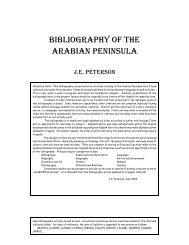THE ARABIAN PENINSULA IN MODERN TIMES: A - JEPeterson.net
THE ARABIAN PENINSULA IN MODERN TIMES: A - JEPeterson.net
THE ARABIAN PENINSULA IN MODERN TIMES: A - JEPeterson.net
You also want an ePaper? Increase the reach of your titles
YUMPU automatically turns print PDFs into web optimized ePapers that Google loves.
The smaller Gulf states have been the subject of relatively less attention. The enduring<br />
experiment of the UAE, contrary to many expectations at its inception, has had to cope with the<br />
necessity of balancing the interests and quirks of seven different but simultaneous rulers, as<br />
Andrea Rugh and Henrik Van Der Meulen show. 12 Kuwait’s experience has also been unique in<br />
another direction, beginning with the consolidation of power in the hands of the Al Sabah and<br />
Kuwait’s willingness to contemplate political participation, along with being the leader in the<br />
Gulf in the learning experience of development. These themes are explored in Kamal Osman<br />
Salih’s articles, B.J. Slot’s books, and the studies by Jacqueline Ismael and Mary Ann Tétreault. 13<br />
The broad scope of Qatari history, including the emergence of the ruling Al Thani in the mid‐<br />
19th century, is the subject of Habibur Rahman’s work. 14 Pithy but comprehensive portraits of<br />
all five countries are to be found in Rosemarie Said Zahlan’s The Making of the Modern Gulf. 15<br />
Prior to 1990, authors tended to concentrate on one or the other Yemen. Since 1990,<br />
Yemen has achieved a long ambition for unification, marred by the expulsion of Yemeni<br />
workers from Saudi Arabia and the loss of nearly all aid in 1990‐1991. It suffered through a civil<br />
war provoked by the South’s attempt to secede in 1994, and an unresolved state of hostilities in<br />
the far north in the 2000s. The country continues to face almost unsurmountable problems of<br />
poverty, alienation, Islamist extremism, corruption, and a growing lack of water. Paul Dresch’s<br />
survey of Yemeni history brings the story of Yemen up to date through the post‐unification era,<br />
thus supplementing and extending earlier country studies. His book complements Sheila<br />
Carapico’s study of civil society in both separate and unified Yemen. 16<br />
One approach in country studies has been to use specific rulers as prisms through which to<br />
filter political developments. Saudi Arabia has been a particularly popular choice for this – as in<br />
the works by Sarah Yizraeli, Uwe Pfullmann, and Joseph Kéchichian 17 – but the undeniable<br />
12. Hendrik Van Der Meulen, “The Role of Tribal and Kinship Ties in the Politics of the United Arab Emirates”<br />
(Ph.D. dissertation, Tufts University, Fletcher School of Law and Diplomacy, 1997); and Andrea B. Rugh, The<br />
Political Culture of Leadership in the United Arab Emirates (New York: PalgraveMacMillan, 2007).<br />
13. Salih, Kamal Osman. “Kuwait: Political Consequences of Modernization, 1750-1986,” Middle Eastern<br />
Studies, Vol. 27, No. 1 (1991), pp. 46-66; ibid., “The 1938 Kuwait Legislative Council,” Middle Eastern Studies,<br />
Vol. 28, No. 1 (1992), pp. 66-100; Ben J. Slot, The Origins of Kuwait (Leiden: E.J. Brill, 1991); ibid., “Kuwait:<br />
The Growth of a Historic Identity,” in Slot, ed., Kuwait: The Growth of a Historic Identity (London: Arabian<br />
Publishing, 2003), pp. 5-29; Jacqueline S. Ismael, Kuwait: Dependency and Class in a Rentier State (Gainesville:<br />
University Press of Florida, 1993); Mary Ann Tétreault, Stories of Democracy: Politics and Society in<br />
Contemporary Kuwait (New York: Columbia University Press, 2000).<br />
14. Habibur Rahman, The Emergence of Qatar: The Turbulent Years, 1627-1916 (London: Kegan Paul, 2005).<br />
15. Rosemarie Said Zahlan, The Making of the Modern Gulf States: Kuwait, Bahrain, Qatar, the United Arab<br />
Emirates and Oman (London: Unwin Hyman, 1989; rev. ed.; Reading: Ithaca Press, 1998).<br />
16. Sheila Carapico, Civil Society in Yemen: The Political Economy of Activism in Modern Arabia (Cambridge:<br />
Cambridge University Press, 1998), and Paul Dresch, A History of Modern Yemen (Cambridge: Cambridge<br />
University Press, 2000). Relevant although sharply different articles include Robert D. Burrowes, “Prelude to<br />
Unification: The Yemen Arab Republic, 1962-1990,” International Journal of Middle East Studies, Vol. 23, No. 4<br />
(November 1991), pp. 483-506; Nahida Cousson<strong>net</strong>, “Les assises du pouvoir zaydite au XIIIe siècle,” Revue du<br />
Monde Musulman et de la Mediterranée, No. 67 (1993), pp. 24-37; and Jacque Couland, “Genèse et étapes de<br />
l’unité yéménite: trois décennies pour conclure,” Revue du Monde Musulman et de la Mediterranée, No. 67 (1993),<br />
pp. 79-93. There is also the study of the National Liberation Front in South Yemen by a Russian scholar of the area,<br />
Vitaly V. Naumkin, Red Wolves of Yemen: The Struggle for Independence (Cambridge, UK: Oleander Press,<br />
2004).<br />
17. Sarah Yizraeli, The Remaking of Saudi Arabia: The Struggle Between King Sa‘ud and Crown Prince Faysal,<br />
1953-1962 (Tel Aviv: Tel Aviv University, Moshe Dayan Center for Middle Eastern and African Studies, 1997);<br />
6







